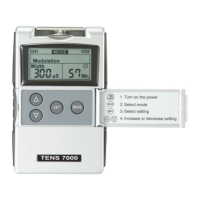
Do you have a question about the Roscoe Medical TENS 7000 and is the answer not in the manual?
| Type | TENS Unit |
|---|---|
| Channels | Dual |
| Pulse Rate | 2-150 Hz |
| Pulse Amplitude | 0-100 mA |
| Power Source | 9V Battery |
| Intensity Levels | Adjustable |
| Warranty | 1 Year |
| Pulse Width | 50-300 µs |
| Modes | Burst, Modulated |
| Timer | 60 minutes |
Explains pain as a warning system and its role in the body.
Describes TENS as a non-invasive, drug-free pain control method.
Explains the mechanism of TENS in stimulating nerves to relieve pain.
Advises reading the manual and following cautions/warnings for user safety.
Lists the intended uses of the device for temporary pain relief.
Notes federal law allows over-the-counter sales without prescription.
Advises consulting a physician for undiagnosed pain.
Warns patients with implanted devices to consult a doctor.
Advises consultation for heart disease, epilepsy, cancer, etc.
Warns against stimulation across the chest to avoid cardiac arrhythmia.
Prohibits stimulation over the carotid sinus due to airway/heart effects.
States TENS devices do not cure underlying conditions.
Explains TENS as pain sensation suppression, not cure.
Notes TENS is not effective for pain originating centrally like headaches.
Warns of potential interference with ECG monitors.
Advises caution for patients with heart disease due to limited data.
Lists prohibited electrode placement sites (eyes, mouth, chest, etc.).
Prohibits use during sleep.
Advises against use during pregnancy without medical direction.
Warns of burns near surgical devices due to simultaneous connection.
Notes potential output instability near shortwave/microwave devices.
Do not use TENS over the carotid sinus (neck) region.
TENS can affect demand-type cardiac pacemakers.
Avoid use with heart disease without physician consultation.
Do not stimulate sites that cause current flow through the head.
Do not use for undiagnosed pain until etiology is established.
Skin irritation and electrode burns are potential adverse reactions.
Describes the TENS 7000 as a battery-operated pulse generator.
Mentions two independent output channels, each with an electrode pair.
Notes ease of use and LCD display for parameter values.
Details dual channels and adjustable pulse amplitude.
Specifies waveform, voltage, and power source.
Lists device size and weight.
Details adjustable pulse rate and width ranges.
Describes Burst, Normal, Modulation, SD1, SD2 modes.
Details adjustable timer from 1-60 minutes or continuous.
Notes storage of 60 operation records and 999 hours total time.
Describes the LCD indicator for low battery.
Lists temperature, humidity, and pressure ranges.
Mentions +/-5% tolerance for parameters and +/-20% for amplitude/voltage.
Lists parts like lead wires, electrodes, battery, belt clip, etc.
Lists included accessories like electrodes, leads, battery, manual, case.
Explains symbols like Type BF applied part, timer, low battery, increment/decrement.
Details installing battery and connecting lead wires.
Instructs on placing electrodes on the body.
Explains pulse width and its effect on stimulation.
Explains pulse rate and its role in nerve stimulation.
Details inserting lead wires into device sockets and attaching to electrodes.
Warns not to plug lead wires into AC power sockets.
Advises cleaning wires with a damp cloth and talcum powder.
Discusses disposable electrodes and replacement.
Provides guidelines for electrode placement (distance, alternatives).
Describes placing electrodes alongside the pain site.
Advises washing, drying, and clipping hair before applying electrodes.
Suggests applying from center outward to avoid pulling stress.
Recommends removing electrodes in the direction of hair growth.
Suggests using lotion and avoiding broken skin.
Details cleaning skin, connecting wires, and applying electrodes.
Explains how to turn off the unit and remove electrodes.
Advises storing electrodes in a resealable bag.
Lists important points like not applying to broken skin or sharing.
Mentions a lid covering controls for mode and setting adjustments.
Explains how to turn on/off and adjust intensity.
Lists precautions for battery removal and recycling.
Provides instructions for using rechargeable batteries.
Details the process of charging the device's battery.
Advises using non-flammable cleaning solution and avoiding liquids.
Recommends using the carrying box with sponge foam for transport.
Instructs on removing batteries and storing in a cool, dry place.
Specifies temperature, humidity, and pressure ranges for storage/transport.
Advises checking the device for external damage and socket issues.
Advises checking operating elements and label legibility.
Advises checking accessories like cables, electrodes, and battery.
Suggests checking parameters, cable connection, and battery for malfunctions.
States warranty covers stimulator parts and labor for one year.
Lists exclusions like damage from misuse or unauthorized disassembly.